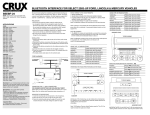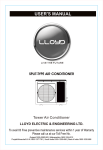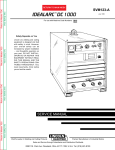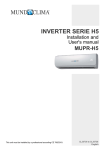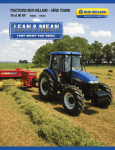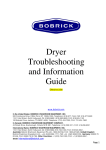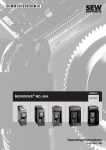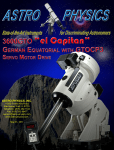Download Electrolux C290R Service manual
Transcript
Service Manual C240 - C260 C240R - C260R - C290R 487 03 29 91/EN 08.28 Service manual Overview Machine presentation 1 Technical data 2 Description of principal components 3 Service Instruction Periodic maintenance 11 Function sequences 12 Machine units and components Automatic unit 21 22 23 24 25 26 27 28 Lid and lid lock 29 Motors 30 31 Included units and somponents 32 33 34 35 36 37 38 39 40 41 Drum 487 03 29 91 1 Service manual Machine presentation 1 General The extractors described in this manual, with drum volumes 38, 58 and 88 litres, are an invaluable complement to the washing machine and other drying equipment. Through their efficient extraction of the water from the load after a wash program, the drying time can be considerably reduced. Drying wash in a drying cabinet or tumble dryer is energy-intensive and an efficient extractor can save a great deal of energy every year. 1 The machines are available in two types: • Flexibly-mounted type (38 and 58 litre drum volumes). The drum is mounted flexibly in relation to the frame. As a result, a minimum of vibration is transferred to the frame, and this in turn makes installation easier. These extractors can generally be installed using expanding bolts (size M12) directly on a cast concrete floor of good quality and sufficient thickness. • R-model (38,58 and 88 litre drum volumes). The drum is relatively rigidly mounted in the frame. The floor must be very stable to take up the dynamic forces from extraction. The mounting bolts must be cast inti the floor. The extractor is controlled by means of three buttons on a control panel. The buttons have the following functions: Start Starts the extractor. It will run for 5 minutes (factory settings) and then switch off automatically. Stop Is used to stop extraction before the set time has elapsed. Opens the lid when the drum has stopped after the set time has elapsed, if extraction has been interrupted using the stop button, if the extractor has stopped because of load imbalance, or if it has been energised with the lid closed. 1 Lid Service door 487 03 29 91 1.1 1 Machine presentation Service manual Safety rules • The machine must not be operated be children. • Do not leave children alone or unsupervised in the vicinity of the extractor. • The machine must not be hosed down with water. • Installation and servicing are to be performed be authorised personnel only. • The machine´s lid lock must not be bypassed under any circumstances. • The extractor must not be connected to a central time-switch which cuts the power supply to it at a certain time each day. If the power supply is cut during an extraction cycle the lid cannot be opened. This means that there is a risk of the lid being forced open. • If a fault arises, e.g. when the yellow light by the STOP button flashed on and off, this should be reported to the technician responsible for the machine as soon as possible. This is important for your own safety and that of other people. 1.2 487 03 29 91 Service manual 2 2. Technical data Technical data Type C240 (R) C260 (R) C290R Dimensions: Width Depth Height 515 mm 660 mm 850/910 mm 640 mm 785 mm 870/980 mm 770 mm 910 mm 1050 mm Weight Drum Diameter, base Diameter, top Height Volume 74/85 kg 109/140 kg 190 kg 400 mm 350 mm 340 mm 38 litres 530 mm 450 mm 305 mm 58 litres 630 mm 556 mm 320 mm 88 litres Capacity 8 kg 12 kg 18 kg Speed 50Hz 60 Hz 1450 rpm 1740 rpm 1450 rpm 1740 rpm 1450 rpm 1740 rpm G-factor 50 Hz 60 Hz 440 635 575 830 705 1015 Power output 50 Hz during operation 60 Hz during operation 0,33 kW 0,40 kW 0,45/0,55 kW 0,65 kW 0,55/0,65 kW 0,75 kW Drain Hose, inner diameter Ø 75 mm Ø 75 mm 487 03 29 91 Ø 75 mm 2.1 Service manual 3. Description of principal components 3 The machine are available in two types: • Flexibly-mounted, which means that the drum unit (motor and drum) are suspended in the frame by rubber straps. Beneath the motor is a counterweight which counterbalances the drum when it is rotation. • R- model, in which the drum unit is relatively mounted in the frame on rubber bushings. An out of balance switch stops the motor if the load is not distributed properly in the drum. The machine lid is on a slewing arm, which is swung across the drum opening and then pressed down towards the drum. A microswitch in the control unit and also a Reed element in the C240/C240R and C260/C260R models check that the lid is closed before the machine will start. Two rotation guards, a microswitch and the Reed element lock the lid so that it cannot be opened until the drum had stopped. If the power supply is interrupted, e.g. by a power cut, it will not be possible to open the lid until the power supply is restored. The machine is controlled by means of three buttons on a control panel located to one side of the lid. The circuit board for automatic functions, lid lock, relays, transformer etc. are located in the control unit. Access is easy once the cover is removed. 1 R- C240/ C260R C290R 487 03 29 91 3.1 Service manual 11. Periodic maintenance 11 The following maintenance routines should be adhered to, to ensure satisfactory and safe operation, and to prevent service stops. The service intervals set out here are suitable for machines in normal use, for example in a communal laundry in an apartment building. The intervals should be halved if the machines is used intensively, e.g. in a commercial laundry. Once every two weeks It is important to check the machine´s functions regularly, in particular the safety aspects. Check: • That the lid cannot be opened when it is extracting • That it stops extracting when the STOP button is pressed • That switches and electrical supply cable are undamaged Once every two years Check the rubber straps supporting the drum unit, and replace them if necessary. See section 42 “ The drum and its mountings - replacement of mountings” 487 03 29 91 11.1 Service manual 12. Functions sequences 12 Functonal diagram for hydro-ectrator 487 03 29 91 12.1 12 12. Functions sequences Service manual General To facilitate fault-tracing in the electrical system, the description which follows has been divided into function sequences. At the end of this section there is also a table listing a number of measurement points. The following sequences are described here: • Power supply • Start of extraction • Lid opening • Stop after extraction • Imbalance during extraction • Measurement points Power supply (230V, 50 Hz; 400-415V, 50 Hz; and 440V, 60 Hz) Machine power supply can be 230, 400, 415 or 440 V 3 AC. An auxiliary transformer is supplied with two of the line voltage phases and steps down the mains voltage to 24 V control voltage. The auxiliary transformer is protected by two fuses, one on the primary side (F1) and one on the secondary side (F2). 1 The auxiliary transformer supplies the circuit board for automatic functions and the other components in the control circuit with control voltage. 1 R2-R1 12.2 487 03 29 91 Service manual 12 12. Functions sequences Power supply (380 V 60 Hz) Machine power supply can be 380 V 3 AC. An auxiliary tranformer is supplied with two of the line voltage phases and steps down the mains voltage to 24 V control voltage. The auxiliay tranformer is protected by two fuses, one on the primary side (F1) and one on the secondary side (F2). 2 The auxiliary transformer supplies the circuit board for automatic functions and the other components in the control circuit with control voltage. 2 C290R R2-R1 Terminal connections (X1) 487 03 29 91 12.3 12 12. Functions sequences Service manual Circuit diagram 489 50 01 77 has been used in describing the function sequence in this section: This diagram is in principle identical to all the other circuit diagrams since the control voltage is 24 V AC 50/60 Hz. Start of extraction 3 The machine starts extraction when the operator presses the START button on the control panel. Drive motor M1 is energised via connection X3-X5 (star connection) or X2-X7(delta connection) when relay K1 operates. For K1 to operate, the following conditions must be fulfilled: • The lid´s Reed element R1-R2 must be activated, e.g. the lid closed (this does not apply to the C290R, which has no Reed element in the lid). • The mechanical lid switch (SW1) must be activated (lid Closed). When the lid´s Reed element closes, a signal (GND potential) is obtained at terminal OUT1 S3 on connection S3. This signal is supplied via the circuit board to terminal GND2 on connection S6. Terminal OUT2 on S6 will have GND, potential, which allows the extractor to start.The logic circuit will now supply control voltage to terminal S1:4, which via an interlock contact on brake relay K2 supplies one side of relay coil K1. The other side of the relay coil receives voltage from S1:2 via lid switch SW1 and the motor´s internal thermal protection F3. When K1 operates, an interlock contact in the control circuit opens to relay K2 (brake relay), thereby preventing K2 from operating at the same time as K1. 12.4 487 03 29 91 Service manual 12 12. Functions sequences 3 R1-R2 R1 R2 S3:out 1 S6:out 2 S1:2 S1:4 S1 K2 K1 M1 F3 487 03 29 91 12.5 12 12. Functions sequences Service manual Lid Opening 4 The lid is opened by pressing the button on the control panel. The following conditions must be fulfilled before the lid will open: • The machine power supply must be on • The drum must be completely at a standstill i.e. rotation guards H1 (S4:2) and SW2 (S1:7) must have sent the opening signal. The lid lock is released with the aid of the traction magnet Y1. The control circuit of Y1 takes its voltage from the circuit board, output S1:6, via rotation guard SW2. When the drum is completely still rotation guard H1 gives the go-ahead signal for lid opening to the logicsection on the circuit board (S4:2). 12.6 487 03 29 91 Service manual 12 12. Functions sequences 4 R1 S1:6 R2 S1:7 S4:2 Y1 H1 SW2 487 03 29 91 12.7 12 12. Functions sequences Service manual Stop after extraction The machine will stop extracting in the following three cases: • When the preset extractor time has elapsed (approx. 5 minutes). • When the operator presses in the STOP button on the control panel. • When the out of balance switch is activated. 5 The machine´s braking function on the circuit board (output S1:5) is activated after the control circuit to extraction relay K1 (S1:4) has been broken. The control circuit for the braking relay K2 is closed (interlock contact in K1 closed), after which K2 operates and inverts the phase of the drive voltage to motor M1, Which thereby gains braking power. When K2 operates, an interlock contact in the control circuit opens to relay K1 (extraction relay) and prevents K1 from operating at the same time as K2. When the logic circuit detects that the motor has stopped (rotation guard H1 (S4:2) and SW2 (S1:7) have sent impulses), K2 is de-energised again and the machine is ready for lid opening. 12.8 487 03 29 91 Service manual 12 12. Functions sequences 5 R1 R2 S1:4 S1:5 S1:7 S4:2 K2 K1 H1 M1 SW2 487 03 29 91 12.9 12 12. Functions sequences Service manual Imbalance during extraction 6 In the event of imbalance, extraction is halted so that the load can be manually redistributed. The sensor arm of the microswitch (SW3) is activated if there is load imbalance, and it in turn sends a signal to the circuit board (S2:2) for activation of the braking function and subsequent possibility of lid opening function. 12.10 487 03 29 91 Service manual 12 12. Functions sequences 6 R1 R2 S2:2 SW3 487 03 29 91 12.11 12 Service manual 12. Functions sequences Faults and corrective action required Faults indecated by flashing yellow light Fault Possible cause Action 1. The extractor will not start. Yellow light flashing. Reed element ring in the deck is defective Disconnect main power supply to extractor. Check that the two connentions of the Reed ring to the circuit board for automatic functions are OK. If they are sound, replace the Reed ring. 2. The extractor has switched to braking during extraction. The extractor will not restart. The Reed in the deck or the microswitch SW1 has developed a defect during extraction. Disconnect main power supply to extractor. Check that the two connections of the Reed ring to the circuit board for automatic functions are OK. If they are sound, replace the Reed ring. Check that the microswitch SW1 is OK. 3. The yellow light starts flashing upon braking. The brake switches off and the extractor remains locked. The Hall element of the is defective. Disconnect main power supply to extractor. Check the 3-pole connection to the circuit board. If this is sound, replace the motor. 4. No signal comes from the machine´s mechanical rotation guard upon braking (at the point where the drum begins to rotate anticlockwise). • The microswicth of the rotation guard has stuck in its rest position. Disconnect main power supply to extractor. Remove cover of automatic control unit. Open extractor lid manually by pressing the yoke of the traction magnet upwards. The drum rotates anticlockwise for approx. 1 1/2 minutes and then braking switches off and the yellow light starts to flash (time varies according to machine type, load and frequency). • The microswitch of the rotation guard has moved from its position. • The motor brake pads are worn The extractor´s lid remains locked. Connect a multimeter between connections 502 AC and 503 AC (S1:2-7) Turn the drum anticlockwise by hand. If the rotation guard is sound the meter should react. If the meter does not react - check the contacts in the 4-pole connection block X8/X9) and the 3-pole connection block X10/X11. If contact is correct from X10 to S1 replace the motor. 5. The signal from the machine´s mechanical rotation guard is constantly active. Braking switches off immediately. The extractor lid remains locked. The yellow light flashing after approx. 1 1/2 minutes. The rotation guard microswitch has burnt out in the active position. Disconnect main power supply to extractor. Remove cover of control unit Open extractor lid manually by pressing the yoke of the traction magnet upwards. Connect a multimeter between connections 502 AC and 503 AC (S1:2-7) If the rotation guard is sound the meter should react. if the meter does not react - check wires and connection blocks X8/X9 and X10/X11 for short circuits. If there is no short circuit in the control unit, the microswitch in the motor is faultyreplace the motor. 12.12 487 03 29 91 Service manual 12 12. Functions sequences Fault Possible cause Action 6. Extraction interrupted and lid remains locked. After the full extraction time has elapsed and when the drum is at a standstill the yellow light starts flashing. The motor´s internal thermal protection Disconnect main power supply to has cut out the motor during extractor. Remove cover of control unit. extraction. open extractor lid manually by pressing the yoke of the traction magnet upwards. Connect a multimeter between S1:2 (cable 502AC) and SW1:C (cable 512L) If the thermal protection is sound the meter will react. If the meter does not react - wait for about 1 hour and check with meter again (if a sound thermal protection device trips, it will return to normal automatically). If the fault remains - replace the motor. Faults indicated by means other than flashing yellow light Fault Possible cause Action 7. The machine will not start when the START button is pressed (even when the lid has been opened and closed again). Fault, in control unit, between S2:1 and microswitch SW1. Disconnect main power supply to extractor. Remove automatic control unit cover. Use a multimeter to check (with the extractor lid OPEN) the connection betweeen S2:1 (cable 508L) and SW1:C (cable 512L). The light by the OPEN LID button keeps falshing. Change falulty cable or microswitch S1. 8. The machine will not start, but the START light comes on after the START button is pressed. The lid of the extractor remains locked. After opening the lid manually by pushing on the yoke of the traction magnet, the yellow light starts to flash. 487 03 29 91 Fault, in control unit, between the coil of K2 and microswitch SW1:C. Disconnect main power supply to extractor. Remove control unit cover. Use a multimeter to check (with the extractor lid CLOSED) the connection between SW1:C (cable 512L) and the coil of K2 (CABLE 511LB). Change faulty cable or microswitch SW1. 12.13 12 Service manual 12. Functions sequences Measurement points A number of measurement points are shown in the adjacent diagram. The table below shows what each measurement is for, where to measure and the value which you should obtain. The measurements described below should be made with extractor in inactive state, i.e. with the drum not rotating. Special care must be taken at the measurement points for the edge connections to the curcuit bourd for automatic functions. The “measurement covers” for connections must be opened with no power supply present (Main switch - Off). Edge connection X16 supplies the primary voltages to the auxilliary transformer, when measuring S3 and S6 of the Hall element, small thin measuring clips for digital meters must be used. Pos. signal Measurement point Correct value A X1:L3,L2 and L1 115V, 200V, 208-240V, 230V, 380V, 400V, 415V or 440V B Primary voltage X16: 1-3 As above C Secondary voltage from transformer. X17:1-2 24V AC D Power supply, circuit board Power supply, circuit board S1: 1-2 S1: 2-3 24V AC 24V AC E Hall element in motor, power supply. S4: 3-1 5V AC output** S4: 2-1 Incoming mains voltage. to aux. transformer. 5 V DC 1 rev 0 V DC F*Reed sensor 1 in lid S3: 1 GND1 - 2 out 1 Open lid ∞ Ω Closed lid 0 Ω Reed sensor 2 in lid S6: 1 GND2 - 2 out 2 Open lid ∞ Ω Closed lid 0 Ω F*Except C290R ** 0 V DC cannot be measured with an ordinary digital meter during operation. This potential can be checked with the lid open and by slowly turning the drum clockwise by hand. 12.14 487 03 29 91 Service manual 12 12. Functions sequences R1 F R2 E D C B A 487 03 29 91 12.15 Service manual 21 21. Automatic unit Component units 1 (230V 50 Hz; 400- 415V 50 Hz and 440V 60 Hz) K1 Relay, extraction K2 Relay, brake T1 Auxiliary transformer - supplies power to the electronics unit, and provides control voltage 24 V AC to components. The transformer is switchable for mains voltages: 230 V, 400 V, 415 V and 440 V. F1 Precision fuse M 0.2 A/500 V - protects primary side of auxiliary transformer. F2 Precision fuse T 2.5 A/500 V - protects secondary side of auxiliary. SW1 Microswitch - detects position of lid lock. CP Control panel with push-button and indicator lights. Y1 Lock magnet - operate the lid lock. MP Circuit board. X1 Terminal connection. 1 CP MP Y1 Lid lock F2 SW1 K2 K1 T1 X1 F1 487 03 29 91 21.1 21 Service manual 21. Automatic unit Component units (380 V, 60 Hz) 1 K1 Relay, extraction K2 Relay, brake T1 Auxiliary transformer - supplies power to the electronics unit, and provides control voltage 24 V AC to components. The transformer is connected for the mains voltage 380 V. F1 Precision fuse M 0.2 A/500 V - protects primary side of auxiliary transformer. F2 Precision fuse T 2.5 A/500 V - protects secondary side of auxiliary. SW1 Microswitch - detects position of lid lock. CP Control panel with push-button and indicator lights. Y1 Lock magnet - operate the lid lock. MP Circuit board. X1 Terminal connection. 1 CP MP Y1 Lid lock F2 SW1 K2 K1 T1 X1 F1 21.2 487 03 29 91 Service manual 29 29. Lid and lid lock Lid lock 1 The lid is mounted on an arm and closes onto the deck of the outer casing. 1 CP Arm The extractor is closed by first moving the lid over the drum and then pressing the arm downwards. The arm activates a mechanical lid lock which prevents the lid from being opened during extraction. Traction magnet To prevent the machine from being able to start with the lid open there is a microswitch which detects when the lid lock is engaged. Reed elements in the lid (on the C240/C240R and C260/C260R) sense when the lid is pressed down towards the deck. The lid lock is opened by activating a traction magnet which releases the mechanical lock. For it to be possible to open the lid, the machine needs to be supplied with power and the machine´s mechanical rotation guard and the motor´s Hall element need to have given the opening signal (drum not rotating). The lid opened by pressing the moving the arm to one side. 487 03 29 91 Lid lock Micro Switch SW1 button and 29.1 29 29. Lid and lid lock Service manual Reed element C240, C240R, C260 and C260R General The function of the Reed element is to check that the lid is properly closed before extraction can start. A complete Reed ring consists of two Reed elements, set the ring itself, beneath the deck. The cable from the Reed ring is routed out through the edge of the deck via the control box down to the automatic control unit. The lid is adjusted so that the machine will stop if the lid is moved upwards or sideways by force from inside or outside the machine during extraction. Once the extractor has stopped it can be restarted provided that the lid is properly closed. Instructions for repair If the lid is too sensitive during extraction the machine will stop. This may be caused by a slight lateral movement of the lid. The cause of the fault may be: • The round rubber dampers are missing or are very worn. Check the dampers in the control unit. If they are missing or worn the lateral movement will be too great. • The lid is not centred over the opening. The lid is attached to the arm with a bolt and locked with a rivet. Check these fastenings. • The lid is too high. Check the position of the lid when it is opened and moved sideways. The lid should be as close as possible to the deck. If the clearance is too great, adjust at the nuts which hold the automatic control unit in place. • The Reed element is defective. Check according to section 12 “ Function sequencesmeasurement points” To replace a Reed ring • Remove the two cable connections on the curcuit board for automatic functions. • Remove nut and washer (C260 and C260R - 2 of these) securing the Reed/Hall ring (use a socket wrench) • Pull the cables out through the hole in the deck. • Remove the Reed/Hall ring from the deck. • Install a new Reed ring. 29.2 487 03 29 91 Service manual 30. Motors 30 Description (230V 50 Hz; 400-415V 50 Hz and 440V 60 Hz) The motor is mounted under the drum and drives the drum directly on its output shaft. To reduce motor noise and vibration the entire drum unit has rubber dampers. On flexiblymounted models this damping is provided by either eight or ten rubber straps, while the drum models this of R- models is mounted on two relatively rigid rubber bushings. 1 Electrical connection is to block X1 in the control unit. The extractor connection is to block X1 in the control unit. The extractors are prepared for switching between star connection (400 - 415V) and delta connection (230V). Switchover is performed by changing a cable set between relay and motor. For 440V 60 Hz, cable set A is used. Cable set A = star connection Please note! When the extractor connection type is being switched over, the auxilliary transformer must also be switched accordingly. 1 When switching over the auxiliary transformer the strap on the transformer connection block should be moved to the desired voltage. A 487 03 29 91 B 30.1 30 30. Motors Service manual Description (380 V, 60 Hz) The motor is mounted under the drum and drives the drum directly on its output shaft. To reduce motor noise and vibration the entire drum unit has rubber dampers. On flexiblymounted models this damping is provided by either eight or ten rubber straps, while the drum unit of R-models is mounted on two relative rigid rubber bushings. 2 Electrical connection is to block X1 in the automatic control unit. The extractors are connected with cable set A between relay and motor. 2 A 30.2 487 03 29 91 Service manual 30. Motors 30 Fault-tracing Motor does not run at all. • Check the power supply to the motor. Check the motor´s quick connector. • Check the motor windings with an ohmmeter for short-circuit or failure. • Check that the motor shaft can be turned. If it can´t, the probable cause is bearing failure. Replace the motor. • If, right after stopping, the motor feels abnormally hot, its thermal protection has probable tripped. Investigate the cause of the overloading. Check that motor and drum rotate easily. The motor protection resets automatically when the motor has cooled, after about 30 minutes. Start the machine and listen for any untoward noise. If the motor protection trips repeatedly, it may be because of short-circuiting. Bearing failure in the motor may be the cause. Motor runs slow The motor is probably operating on only two phases. • Check that the motor´s power supply is correct. • Remove the quick connector and use a meter to check the motor windings for failure or short-circuiting. Motor is very noisy or seizes • Bearing failure, replace motor 487 03 29 91 30.3 Service manual 42 42. Drum Description 1 These are two methods of mounting the drum unit in the frame: one for the flexibly-mounted type, the other for R-model. • In the flexibly-mounted models (C240 and C260) the drum unit is suspended from rubber straps: 8 or 10 according to type. In these models the mounting cannot be adjusted, instead the rubber replacement is needed, then all the straps must be replaced where necessary. If replacement is needed, then all the straps should be replaced with new ones at the same time, to avoid having to replace others only a short time later because of uneven strap elestictity. • In R-models (C240R, C260R and C290R) the drum unit is relatively rigidly mounted in the frame with the aid of two rubber bushing. 2 Instructions for repair Flexibly-mounted models (C240 and C260) Check the rubber straps on which the motor is mounted, and replace where necessary. Procedure: • Remove the two service covers. 1 • Lift the motor, holding it under the counterweight, until the drum reaches the inside of the top deck. 2 • Prop it from beneath to keep it in raised position. 3 • Replaced the rubber straps, one at a time, through the service openings. 3 • Lower the motor. Check that all rubber straps are positioned correctly. 487 03 29 91 42.1 42 Service manual 42. Drum R-models (C240R, C260R and C290R) 5 Checking and adjusting the rigidty of the drum mounting. The rigidity of the drum mounting is adjusted by means of the nuts above the bushing: three nuts or four according to model. 20-30 mm Check: • That the drum is not too loosely restrained. 5 6 Press hard on the drum edge. It should not be possible to press the drum in more than 20-30 mm. If the mounting is too loose, tighten the three or four nuts above the bushing. 6 • That the drum is centret, correct this by adjusting one or more of the nuts on top of the bushing. 7 Look straight down at the extrator drum from above and compare the drum edge with the opening in the casing. If the drum is not centred, correct this by adjusting one or more of the nuts on top of the bushing. If any of the nuts should reach the end of its thread when adjusted, the rubber bushings must be replaced, see under heading “To replace rubber bushings”. 7 Please note! On the C260R and C290R a loose nut can cause noise. The spring washers under the nuts increase the latitude of movement. A B A=B To replace rubber bushing. • Remove the drain hose. • Remove the cover over the control unit. Disconnect the cables from the control unit to the motor, imbalance switch and outer casing. - Disconnect the 6-, 3- and 2-pole connectors. 8 - Disconnect the 3-pole edge connector on the circuit board for automatic functions. - Disconnect the two yellow/green earth connectons in the automatic control unit. - Pull the freed cables down through the conduit between control unit and outer casing so that they are clear of the extractor´s outer casing. 8 42.2 • Remove the cap nut securing drum to motor shaft. Remove drum. Use a special puller (see figure). 487 03 29 91 Service manual • Remove the bolts around base of outer casing. Lift outer casing and control unit straight upwards. 9 42 42. Drum 9 • Remove the three or four nuts securing the bushing. Lift the motor straight upwards. • Replace the two rubber bushings. When you replace the upper bushing, do not remove the supporting journal from the motor. It can be difficult to adjust when it is put back. 10 Instead, remove the old bushing by cutting it off. Make a cut in the new bushing as illustrated and put it in place on the supporting journal. The vibration from the extractor causes the surfaces of the cut to vulcanise together after it has been in use a while. 10 • C240R 11 - Position supporting journal in recess in base plate and loosely tighten the three nuts above the bushing. • C260R, C290R 12 11 - Position supporting journal in frame. Make sure that the pins on both supporting journal and frame are corrected positioned in the corresponding holes of the lower rubber bushing. 15mm - Tighten the outer nuts loosely at the top of the bushing. Use the spring washers under the nuts. • Reinstall the outer casing and the cables to the automatic control unit. 12 • Check the drum and complete the adjustment of the four nuts according to the instructions under the heading “checking and adjusting the rigidity of the drum mounting. 487 03 29 91 42.3 www.electrolux.com/laundrysystems Share more of our thinking at www.electrolux.com








































